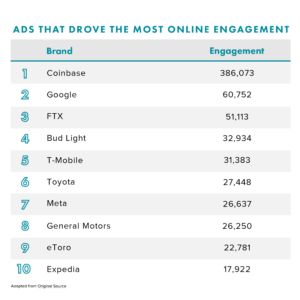Lessons Learned on QR Code Marketing
Super Bowl LVI may be remembered for a few things but among them for marketers will be…QR code marketing? While most probably had flashbacks of the DVD logo bouncing around the TV screen in their school library, Coinbase invoked the at-times-maligned QR code to compel viewers to their site in an otherwise quite plain (and completely brandless) Super Bowl ad. Though plain, the ad drove results most advertisers would welcome – nearly 400,000 visitors engaged with their site as a result. At a reported $14 million for the <1 minute ad, that might seem like a hefty price per visitor. But, considering how other brands fared at similar price points, it was over 6x as effective in driving engagement compared to its nearest competitor – Google.
So, yes, a huge jump in website engagement is great but ultimately the question becomes – is QR code marketing making a comeback?
Did COVID Save the QR Code? (Yes)
The QR code realized the first step in its comeback story shortly following the advent of the COVID-19 pandemic. In an effort to help consumers and shoppers feel safe, restaurants and stores started to eschew physical menus and product sheets for digital versions accessible via well-placed QR codes. It was a solid strategy to address an issue many hoped would be short-term. As the pandemic has lingered, some have adopted QR codes permanently, citing all manner of reasons from convenience (we’re able to easily make updates) to sustainability (and those updates don’t require a massive print order).
In this instance, QR codes were a stop-gap measure that addressed a short-term challenge. But, as consumer behavior has been permanently altered, the real success of the QR code is one most brands should prioritize in their brand and marketing strategy going forward.
The Marriage of Digital and Physical with QR Code Marketing
As society has attempted to move back into a pre-COVID environment, we’re taking all manner of steps to try to return some sense of “normal.” From hybrid work plans to socially distanced events, consumers and every day citizens are fighting to retain some of the aspects of pre-pandemic life. What we’re finding is that the new status quo will be some kind of balance between our physical and digital environs. Straddling the gap between those two worlds is the QR code – a small microcosmic representation of consumers’ new need for connecting the immediacy of their physical environment with the limitless information offered by a digital one.
As brands continue to navigate what in-person shopping and engagement will look like moving through 2022, leveraging QR code marketing in a consumer-centered, authentic way can help not only drive consumer engagement but address many of the other purchasing criteria consumers are now demanding.
Consider a QR code placed on any one product. Once scanned (and largely depending on the core consumer target audience), the QR code could lead a visitor to transparent pricing information on how the product is priced and why. For a more sustainably minded consumer, a page could display detailing that exact product’s origin, how it was sourced and made, and its environmental impact. QR codes on clothing could demonstrate ways the exact outfit is styled by influencers that have partnered with the brand.
The possibilities are nigh-endless but must rest on a foundation of deep understanding of your core consumer. The QR code’s failure in the 2010s is largely attributed to the fact that the information consumers obtained scanning a product’s QR code was largely misaligned with their wants and needs, often taking a visitor to a generic page or site that didn’t speak to their drivers for purchasing the product in the first place. When brands approach QR code marketing intentionally, rather than trying to hop on to the latest gimmick, the opportunities expand exponentially.
Going Forward with QR Code Marketing
As digitalization has enabled greater understanding of consumers, brands have the opportunity to use that understanding to drive effective use of tools like the QR code. As with any modern innovation, data will ultimately drive success in QR code marketing. Learn more about how Clarkston can help you leverage your existing data sets to drive innovative marketing, engagement, and growth strategies here.




